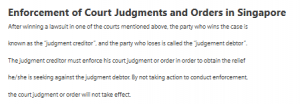Enforcement of Court Judgments and Orders in Singapore

After winning a lawsuit in one of the courts mentioned above, the party who wins the case is
known as the “judgment creditor”, and the party who loses is called the “judgement debtor”.
The judgment creditor must enforce his court judgment or order in order to obtain the relief
he/she is seeking against the judgment debtor. By not taking action to conduct enforcement,
the court judgment or order will not take effect.
The following are some of the different types of enforcement options available to a judgment
creditor:
• Small Claims Tribunals (SCT) – Order of Tribunal
An order of tribunal obtained from the SCT ordering money payments to be made by
the respondent (or judgment debtor) will generally be coupled with a deadline for
payment. If the respondent does not pay, the judgment creditor will have to take up
separate enforcement proceedings against the judgment debtor.
• Writ of Seizure and Sale
A writ of seizure and sale authorises the bailiff to seize and sell movable property
belonging to the judgment debtor to pay the judgment creditor.
• Writ of Delivery
A writ of delivery is a court order requiring the judgment debtor to deliver movable
property to the judgment creditor to satisfy the judgement debt.
• Garnishee Proceedings
Where a third-party owes money to the judgment debtor (such as an employer), a
garnishee proceeding can be taken out so that the garnishee must pay the money to
the judgment creditor instead of the judgment debtor.
• Committal Order
Where the judgment debtor fails to obey a court order, the judgment creditor can apply
to court to have the judgment debtor sanctioned with fine or imprisonment.
• Bankruptcy and Winding Up Applications
Where the judgment debtor cannot pay the debts owed, the judgment creditor can
apply for bankruptcy or winding up proceedings against the debtor depending on
whether the debtor is an individual or a company.
COMMERCIAL LAW
KHE-LCD-SGD-00341 10
General information on Court Procedures – The person making the claim is the Plaintiff. – The person being served or against whom the claim is made is the Defendant. – Depending on the nature and amount of the claim a suit is filed in the appropriate Court. – If the Defendant wishes to settle the claim and not dispute it, he can contact the Plaintiff or the Plaintiff’s lawyer for an out-of-court settlement. If not, the Court will set a date to hear both sides and evaluate all evidence and proof. – There can still be an out-of-court settlement at this point. – Once a ruling is made, it is enforceable. – If the parties refuse to comply, the Court can issue a writ of seizure and sale. This allows the claiming party to seize the assets and sell them to recover his compensation. – The Court’s judgment can be contested by making an appeal to the High Court.